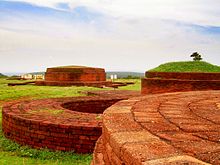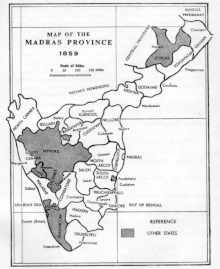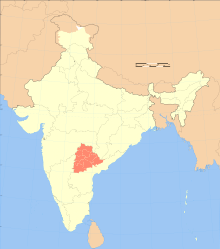History of Andhra Pradesh
Their power increased in the reigns of Mahendravarman I (571–630) and Narasimhavarman I (630–668), and dominated northern Tamilakam and the southern Telugu-speaking region until the end of the ninth century.In 1323 CE, Ghiyath al-Din Tughluq, sultan of Delhi, sent a large army under Ulugh Khan[5] to lay siege to Warangal.Under Krishnadevaraya of the Vijayanagara Empire (1336 CE–1646 CE) the Telugus became independent, then the Qutb Shahi dynasty ruled the Bahmani Sultanate there from the early 16th to the end of the 17th centuries, and was tolerant of Telugu culture.Andhra Pradesh, the first Indian state formed primarily on the basis of language post independence, split off from the Madras Presidency in 1953.According to Megasthenes, who visited the court of Chandragupta Maurya (322-297), the Andhras had 30 fortified towns along Godavari River and an army of 1,00,000[clarification needed] infantry, 2,000 cavalry and 1,000 elephants.The fall of the Satavahana empire left Andhra in political chaos, and local rulers carved out small kingdoms for themselves.[12][13] Some scholars believe that this dynasty was related to the ancient Ikshvakus of the Hindu epics, and Rama of the Ramayana, the incarnation of Vishnu, was descended from the Ikshvaku line.[14] In the Vayu Purana, Manu (the patriarch of ancient India) had nine sons; Ikshvaku, the eldest, founded the Suryavamsha dynasty and ruled from Ayodhya at the beginning of the Treta Yuga.Santamula I founded the Ikshvaku dynasty, performing the Ashvamedha, Agnihotra, Agnistoma and Vajapeya yagnas to proclaim his imperial status.Anandagotras live in Cedaranya of Kadhiri area hill/mountain places called Batrapalli forest, Gogannapeta, Pandava Raju hill and Vankapalli.Lieutenant colonel James Tod recorded a tribe of Haihayas "near the very top of the valley of Sohagpur in Bagelkhand, aware of their ancient lineage, and though few in number, still celebrated for their valour".During the 11th century, the Mahabharata was partially translated by court poet Nannaya under the patronage of the Eastern Chalukya ruler Rajaraja Narendra.Although his reign was characterized by battles against internal and external foes, Prataparudra expanded his kingdom west to Raichur and south to Ongole and the Nallamala Hills, all the way to Kanchipuram.Hakka (Harihara) and Bukka, treasury officers at the court of Prataparudra, were inspired by the Musunuri Nayaks to organise Hindu opposition to Muslim invaders.[24] Inspired by the victories of Prolaneedu and his cousin, Kaapaneedu, other states (including Kampili, Hoysala, Dwarasamudram and Araveedu) asserted their independence.[26] In 1345 Muslim nobles rebelled against Muhammad bin Tughluq in Devagiri, resulting in the foundation of the Bahmani Sultanate by Hasan Gangu.The Vijayanagara Empire was founded by Harihara (Hakka) and Bukka, who were treasury officers in the administration of the Kakatiya dynasty or commanders of Hoysala's forces.Some, however, claim that the founders of the empire were Kannadigas stationed in the Tungabhadra region under Veera Ballala III to fight off Muslim invaders.[46] In a 1753 decree, Deccan subedar Asif ad-Dawlah Mir Ali Salabat Jang ceded Chicacole, Ellore and Rajahmundry to the Marquis de Bussy-Castelnau.It formed alliances with the French and British East India companies to conquer the neighbouring principalities of Bobbili, Kurupam, Paralakhemundi, and the kingdom of Jeypore.[49][43][50][51] Following the annexation of Carnatic sultanate in 1801, the last major piece of the present day Andhra Pradesh came under British East India company rule as part of Madras Presidency.[52] The Nizams retained control of the interior provinces as a princely state, acknowledging British rule in return for local autonomy.[57] Charles Philip Brown did pioneering work in transforming Telugu to the print era and introduced Vemana poems to English readers.According to Paragraph 374 of the report, "The creation of Vishalandhra is an ideal to which numerous individuals and public bodies, both in Andhra and Telangana, have been passionately attached over a long period of time, and unless there are strong reasons to the contrary, this sentiment is entitled to consideration".He was succeeded by Congressmen Konijeti Rosaiah and Nallari Kiran Kumar Reddy; the latter resigned over the impending division of the state to form Telangana.[71] A new party called Telangana Rashtra Samithi, formed in April 2001 by Kalvakuntla Chandrashekar Rao (KCR), reignited the Telanganga movement.When KCR's health deteriorated due to his fast-unto-death programme, the central government decided to initiate the process to form an independent Telangana in December 2009.[81] A number of petitions questioning the validity of the Andhra Pradesh Reorganisation Act have been pending before the Supreme Court constitutional bench since April 2014.[83] In 2017, the government of Andhra Pradesh began operating from its new greenfield capital, Amaravati, for which 33,000 acres were acquired from farmers through an innovative land pooling scheme.[86][87] In the 2019 elections, Y. S. Jagan Mohan Reddy, leader of the YSR Congress Party, became the chief minister by winning 151 out of 175 seats.











Culture of Andhra PradeshEconomy of Andhra PradeshPolitics of Andhra PradeshTelugu peopleTelugu languageAndhra cuisineMusic of Andhra PradeshShadow puppets of Andhra PradeshTelugu literatureTourism in Andhra PradeshTelugu cinemaTelanganaAndhra PradeshGeographyPolitical historyAssakaSatavahanasAndhra IkshvakuAnanda GotrikaSalankayanasVishnukundinasPallava dynastyEastern ChalukyasChola dynastyKota VamsaVelanati ChodasKakatiya dynastyMusunuri NayaksRecherla NayaksPemmasani NayaksVijayanagara EmpireReddy dynastyGajapati EmpireBahmani SultanateSultanate of GolcondaHyderabad StateBritish RajVedic periodSanskrit epicsAitareya BrahmanaGodavariKrishna RiversmahajanapadasAmaravatiGautamiputra SatakarnifiefdomsAndhra IkshvakusTamilakamKanchipuramMahendravarman INarasimhavarman ITelugu-speakingVengi ChalukyasImperial CholasRajaraja Chola ITelugu CholaTikkanaMahabharataTeluguJatavarman Sundara Pandyan INellore CholasPandyan empireGhiyath al-Din TughluqUlugh Khansiege to WarangalDelhi SultanateKrishnadevarayaQutb Shahi dynastyMarquis de Bussy-CastelnauRobert CliveVisakhapatnamNorthern CircarsMughalShah AlamAndhra StatePotti SriramuluMadras PresidencyTanguturi Prakasam PantuluKurnoolN. T. Rama RaoIndia became independentNizam of HyderabadannexedDominion of IndiaLok SabhaChalcolithicTungabhadra riversNavdatoliBronze AgeGreat Stupa of AmaravatiGovernment Museum, ChennaiAmaravati MarblesAmaravati MahachaityaAndhra in Indian epic literatureAitareya BrahamanaYamuna riverVindhyasPundrasPulindasIndian epic poetryRamayanaPuranasVidarbha KingdomDeccan PlateauVindhya RangeMaharashtraMadhya PradeshKarnatakaBay of BengalBhadrachalamBhattiproluGunturBrahmiBavikondaMauryan EmpireDeccanMegasthenesChandragupta MauryaGodavari RiverSatavahana dynastyMatsya PuranaOrissaPrakritVedic religionIkshvakuBruhatpalayana